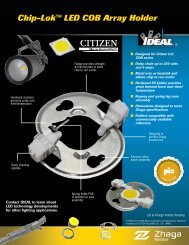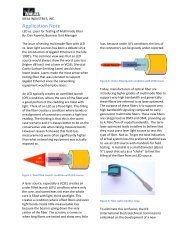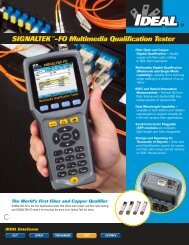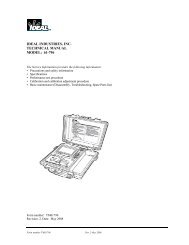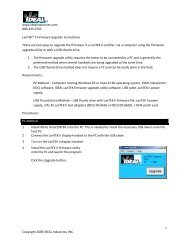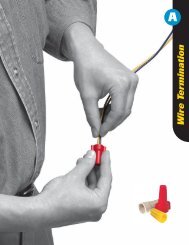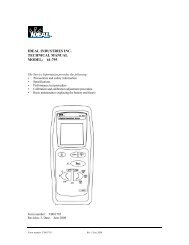LANTEK User Manual - Ideal Industries
LANTEK User Manual - Ideal Industries
LANTEK User Manual - Ideal Industries
You also want an ePaper? Increase the reach of your titles
YUMPU automatically turns print PDFs into web optimized ePapers that Google loves.
CHAPTER 6<br />
FIBER OPTICS DIAGNOSTICS<br />
(TRACETEK TM )<br />
TRACETEK is a Reflective Anomaly Detection (RAD) system composed of two parts:<br />
‣ <strong>LANTEK</strong> Cable Certifiers, and<br />
‣ TRACETEK Optical Transceiver Module<br />
The <strong>LANTEK</strong> Display Handset provides power, user interface, storage and signal<br />
processing capability to the TRACETEK module. The TRACETEK module converts the<br />
<strong>LANTEK</strong> electronic TDR signals to optical and optical signals back to electronic.<br />
The primary use of this system is to locate optical reflections from cable discontinuities<br />
such as connectors, splices, fractures (i.e. cracked or broken strands) or other<br />
anomalies occurring within an optical fiber network.<br />
Warning: The TRACETEK adapter generates light pulses exceeding 40 milliwatts<br />
of power. DO NOT look into the adapter or the fiber under test as serious eye damage<br />
may result.<br />
TRACETEK is an alternative to using an OTDR (Optical Time Domain Reflectometer)<br />
and functions in a similar manner. Both methods will produce traces of optical back<br />
reflection for analysis by technicians. However, the Rayliegh scatter measurement<br />
used by the OTDR to infer fiber loss is not used in TRACETEK.<br />
Note: True loss measurements can only be made with an Optical Loss Test Set such<br />
as TRACETEK’s companion product, FIBERTEK.<br />
TRACETEK VS. OTDR<br />
OTDR OPERATING PRINCIPLES<br />
The OTDR (Optical Time Domain Reflectometer) is a device that is able to “look” at a<br />
fiber optic cable and display a graphical representation of the events that occur on the<br />
cable. The basic concept is that a high-speed laser fires a precise pulse of light into<br />
the fiber, after which the device monitors the same fiber for reflections. The time<br />
between the launched pulse and reflected pulses represents the distance to the events<br />
that caused the pulses. This gives the OTDR the ability to not only measure the length<br />
of the fiber but to also measure the distance to each event on the fiber. This function<br />
allows the OTDR to be used as a trouble-shooting tool to find breaks in the fiber and<br />
to identify the location of individual connectors and splices.<br />
The second feature of an OTDR is its ability to measure the tiny amounts of light that<br />
are reflected back by the fiber optic cable itself. This phenomena is known as Rayleigh<br />
scattering and is caused by light reflecting off molecules in the glass whose diameter<br />
is 1/10 the wavelength of the light. This is the same phenomenon that makes the sky<br />
appear blue. When the OTDR is able to detect these tiny reflections it can calculate the<br />
loss of the cable as well as the insertion loss of connectors and splices on the fiber<br />
cable.<br />
6-1









